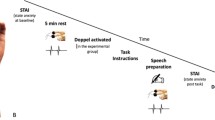Abstract
This study was to determine if verbal incentive is an effective variable in the development of the control of electrodermal fluctuations (EDFs); and if body movement and respiratory artifacts are confounding variables in the feedback control of EDFs. Nonlabiles encouraged to increase EDFs by “thinking emotional thoughts” demonstrated significant increases in both EDFs and body movement and respiratory artifacts. However, persons with few, if any, artifacts showed an almost identical pattern of EDFs as compared to persons with relatively more artifacts in their recordings. Incentive as compared to control groups reported an increased ability to sustain their thinking about emotional events. All groups indicated decreased anxiety from pre- to post-feedback conditions. The findings were related to contemporary theory on cognition.
Similar content being viewed by others
References
Baumeister, R.F. (1990). Suicide as escape from self. Psychological Review, 97, 90–113.
Fowles, D.C., Christie, M.J., Edelberg, R, Grings, W.W., Lykken, D.T., & Venables, P.H. (1981). Publication recommendations for electrodermal measurements.Psychophysiology, 18, 232–239.
Fehr, F.S. (1970). A simple method for assessing body movement and potential artifacts in the physiological recordings of young children.Psychophysiology, 6, 787–789.
Gavalas, R.J. (1968). Operant reinforcement of a skeletally mediated autonomic response: Uncoupling of the two responses.Psychonomic Science, 11, 195–196.
Grings, W.W. (1973) Cognitive factors in electrodermal conditioning.Psychological Review, 79, 200–210.
Klinge, V. (1972). Effects of exteroceptive feedback and instructions on control of spontaneous galvanic skin response.Psychophysiology, 9, 305–317.
Lazarus, R.S. (1984). The trivialization of stress. In B.L. Hammonds & C.J. Scheirer (Eds.),Psychology and health, (pp. 125–144). Washington, DC: American Psychological Association.
Litt, M.D. (1988). Cognitive mediators of stressful experience: Self-efficacy and perceived control.Cognitive therapy and Research, 12, 241–260.
Norusis, M.J. (1988).Spss/pc+advanced statistics V3.1, (pp. C76–82). Chicago, IL: Spss inc.
Pennebaker, J.W. (1989). Stream of consciousness and stress: Levels of thinking. In J.S. Uleman & J. A. Bargh (Eds.),Unintended thought, (pp. 327–350). NY: Guilford Press.
Shapiro, D. (1977). A monologue on biofeedback and psychophysiology.Psychophysiology, 14, 213–227.
Shapiro, D., Crider, A.B., & Tursky, B. (1964). Differentiation of an autonomic response through operant reinforcement.Psychonomic Science, 1, 147–148.
Stern, R.M. & Kaplan, B.E. (1967). Galvanic skin response: Voluntary control and externalization.Journal c c Psychosomatic Research,10, 349–353.
Wegner, D.M. & Schneider D.J. (1989). Mental control: The war of the ghosts in the machine. In J.S. Uleman and J.A. Bargh (Eds.),Unintended thought, (pp. 287–305). NY: Guilford Press.
Wilson, K.G. & Graham, R.S. (1989). Electrodermal lability and visual information processing.Psychophysiology, 26, 321–328.
Zuckerman, M, & Lubin, B. (1965).Manual for the multiple affect adjective check list. San Diego, CA: Educational and Industrial testing Service.
Author information
Authors and Affiliations
Additional information
The present manuscript is based upon a poster presentation at the American Psychological Society Meetings, July 7, 1990. I wish to express my appreciation to John and Carolyn Stern of Washington University, St. Louis, for their kindness and contagious enthusiasm for research.
Rights and permissions
About this article
Cite this article
Fehr, F.S., O’Neil, E. Electrodermal fluctuation as a function of verbal incentive. Current Psychology 11, 254–263 (1992). https://doi.org/10.1007/BF02686845
Accepted:
Issue Date:
DOI: https://doi.org/10.1007/BF02686845




